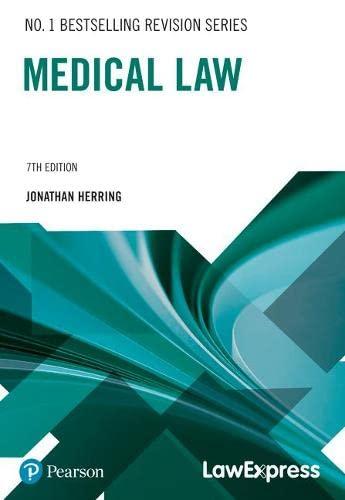Question
Question 1 States A and B are neighbouring States. They are both members of the United Nations (UN) and contracting parties to the 1969 Vienna
Question 1
States A and B are neighbouring States. They are both members of the United Nations (UN) and contracting parties to the 1969 Vienna Convention on the Law of Treaties.
In March 2020, States A and B signed, subject to ratification, a treaty on the establishment of a common national park, including a grazing area for impala antelopes and gazelles (the Treaty). The intended national park is to be located on a 200-acre area in the middle of which runs the border between States A and B. The Treaty provides that 1000 impala antelopes from all regions of State A and 1000 gazelles from all regions of State B will be transported to the territory of the intended national park.
State A, after signing the Treaty, but before its ratification by State B, transported 1000 impala antelopes to the territory of the intended national park. Subsequently, State B, informed State A that it does not intend to ratify the Treaty. 10 days after the notification, State B opened a sanctuary for lions in the area of the intended national park. State A noted that 20 days after the opening of sanctuary for lions at least 10 impala antelopes were eaten by lions. Following from this, State A sent a note to State B demanding the removal of the sanctuary for lions from the territory of the intended national park. State B refused on the ground that lions are endangered species and it is normal for them to eat antelopes and other animals.
Following the refusal of State B to remove the sanctuary for lions, the relations between State A and B have become very tense. State A has recently passed legislation under which citizens of State B residing in State A are refused social assistance benefits, access to employment, and access to free medical care. State B has stated that if the harassment of its citizens does not stop State B will take all appropriate measures, not excluding the possibility of a military action in State A, to protect its nationals residing in State A.
The President of State A learned from the President of State C that State B will be in position to manufacture nuclear weapons in 2021. He considers bombing the factory where he believes nuclear research is carried out and where nuclear weapons will be manufactured. According to him it is likely that State B may use nuclear weapons against State A, and thus he must act now. He also considers starting proceedings before the International Court of Justice against State B. According to him State B is in breach of the Treaty in that State B has refused to close the sanctuary for lions, and in breach of the UN Charter which prohibits the use of force.
Both State A and State B have made declarations under Article 36(2) of the Statute of the ICJ accepting the jurisdiction of the ICJ. State A's declaration states that the ICJ will have jurisdiction over all legal disputes other than disputes relating to acts or situations originating in armed conflict or acts of a similar nature which may affect State A. Whether such acts or situations have occurred is to be determined solely by State A. State B's declaration states that State B accepts, ipso facto and without any condition, the jurisdiction of the ICJ in all legal disputes.
Advise the President of State A on all legal problems raised by the above facts.
Step by Step Solution
There are 3 Steps involved in it
Step: 1

Get Instant Access to Expert-Tailored Solutions
See step-by-step solutions with expert insights and AI powered tools for academic success
Step: 2

Step: 3

Ace Your Homework with AI
Get the answers you need in no time with our AI-driven, step-by-step assistance
Get Started


